Impact of Viscous Droplets on Dry and Wet Substrates for Spray Painting Processes †
Abstract
1. Introduction
2. Experimental Setup and Measuring Techniques
2.1. Investigations of Single Droplet Impacts on Dry Solid Walls
2.2. Investigations of Droplet Impact and Air Entrapment on Wetted Solid Walls Using an Atomizer
2.3. Rheological Properties of the Paint Used for Droplet Impacts on Wetted Solid Walls
3. Basic Numerical Methods
3.1. Simulation of Viscous Droplet Impact on Dry Solid Surfaces
3.2. Simulation of Viscous Droplet Impact on Wet Solid Surfaces
3.3. Simulation of Flake Orientation
4. Experimental Validation of the Numerical Models for the Droplet Impact on Dry Solid Surfaces
5. Simulation of Droplet Impact on Dry/Wet Solid Surface
5.1. Air Entrapment in Droplet Impact Processes
5.2. Evolution of Gas–Liquid Interface at Droplet Impact on Wet Solid Surfaces
6. Simulation of Flake Orientation at Droplet Impact
6.1. Dry Solid Surfaces
6.2. Impact on Wet Solid Surfaces
7. Summary and Conclusions
Author Contributions
Funding
Data Availability Statement
Acknowledgments
Conflicts of Interest
References
- Chandra, S.; Avedisian, C.T. On the collision of a droplet with a solid surface. Proc. R. Soc. Lond. Ser. A 1991, 432, 13–41. [Google Scholar] [CrossRef]
- Fujimoto, H.; Shiraishi, H.; Hatta, N. Evolution of liquid/solid contact area of a drop impinging on a solid surface. Int. J. Heat Mass Transf. 2000, 43, 1673–1677. [Google Scholar] [CrossRef]
- Thoroddsen, S.T.; Etoh, T.G.; Takehara, K.; Ootsuka, N.; Hatsuki, Y. The air bubble entrapped under a drop impacting on a solid surface. J. Fluid Mech. 2005, 545, 203–212. [Google Scholar] [CrossRef]
- Thoroddsen, S.T.; Takehara, K.; Etoh, T.G. Bubble entrapment through topological change. Phys. Fluids 2010, 22, 051701. [Google Scholar] [CrossRef]
- Palacios, J.; Hernández, J.; Gómez, P.; Zanzi, C.; López, J. On the impact of viscous drops onto dry smooth surfaces. Exp. Fluids 2012, 52, 1449–1463. [Google Scholar] [CrossRef]
- Thoroddsen, S.T.; Sakakibara, J. Evolution of the fingering pattern of an impacting drop. Phys. Fluids 1998, 10, 1359–1374. [Google Scholar] [CrossRef]
- Li, E.Q.; Thoroddsen, S.T. Time-resolved imaging of a compressible air disc under a drop impacting on a solid surface. J. Fluid Mech. 2015, 780, 636–648. [Google Scholar] [CrossRef]
- Arogeti, M.; Sher, E.; Bar-Kohany, T. A single spherical drop impact on a flat, dry surface—A unified correlation. At. Sprays 2017, 27, 759–770. [Google Scholar] [CrossRef]
- Wörner, M. Maximum spreading of an impacting drop. Int. J. Multiph. Flow 2023, 167, 104528. [Google Scholar] [CrossRef]
- Mehdi-Nejad, V.; Mostaghimi, J.; Chandra, S. Air bubble entrapment under an impacting droplet. Phys. Fluids 2003, 15, 173–183. [Google Scholar] [CrossRef]
- Kim, E.; Baek, J. Numerical study of the parameters governing the impact dynamics of yield-stress fluid droplets on a solid surface. J. Non-Newton. Fluid Mech. 2012, 173–174, 62–71. [Google Scholar] [CrossRef]
- Ye, Q.; Tiedje, O. Investigation on Air Entrapment in Paint Drops under Impact onto Dry Solid Surfaces. High Perform. Comput. Sci. Eng. 2016, 16, 355–374. [Google Scholar]
- German, G.; Bertola, V. Impact of shear-thinning and yield-stress drops on solid substrates. J. Phys. Condens. Matter 2009, 21, 375111. [Google Scholar] [CrossRef]
- Nigen, S. Experimental investigation of the impact of an (apparent) yield-stress material. At. Sprays 2005, 15, 103–118. [Google Scholar] [CrossRef]
- Šikalo, Š.; Wilhelm, H.-D.; Roisman, I.V.; Jakirlić, S.; Tropea, C. Dynamic contact angle of spreading droplets: Experiments and simulations. Phys. Fluids 2005, 17, 062103. [Google Scholar] [CrossRef]
- Linder, N.; Criscione, A.; Roisman, I.V.; Marschall, H.; Tropea, C. 3D computation of an incipient motion of a sessile drop on a rigid surface with contact angle hysteresis. Theor. Comput. Fluid Dyn. 2015, 29, 373–390. [Google Scholar] [CrossRef]
- Weiss, D.A.; Yarin, A.L. Single drop impact onto liquid films: Neck distortion, jetting, tiny bubble entrainment, and crown formation. J. Fluid Mech. 1999, 385, 229–254. [Google Scholar] [CrossRef]
- Rein, M. Phenomena of liquid drop impact on solid and liquid surfaces. Fluid Dyn. Res. 1993, 12, 61–93. [Google Scholar] [CrossRef]
- Wang, A.-B.; Chen, C.-C. Splashing impact of a single drop onto very thin liquid films. Phys. Fluids 2000, 12, 2155–2158. [Google Scholar] [CrossRef]
- Banks, D.; Ajawara, C.; Sanchez, R.; Surti, H.; Aguilar, G. Effects of drop and film viscosity on drop impacts onto thin films. At. Sprays 2013, 23, 525–540. [Google Scholar] [CrossRef]
- Tran, H.; He, Z.; Pack, M. Microbubble entrainment on thin liquid films under drop impacts. J. Colloid Interface Sci. 2025, 682, 915–923. [Google Scholar] [CrossRef]
- Thoroddsen, S.T.; Thoraval, M.-J. Using drop impacts to study the dynamics of sub-micron liquid structures. In Proceedings of the 15th International Symposium on Flow Visualization, Minsk, Belarus, 25–28 June 2012. [Google Scholar]
- Kirchner, E. Flow-induced orientation of flakes in metallic coatings: II. The orientation mechanism. Prog. Org. Coat. 2018, 124, 104–109. [Google Scholar] [CrossRef]
- Schlüsener, T. Untersuchungen zum Einfluss der thermo- und hydrodynamischen Vorgänge bei der Lackapplikation und -trocknung auf die Farbtonausbildung wasserbasierter Metallic-Lacke. Ph.D. Thesis, Technical University of Darmstadt, Darmstadt, Germany, 2000. (In German). [Google Scholar]
- Saito, Y.; Hashiguchi, N.; Cheng, Z.; Okabe, T.; Miyagawa, T.; Shirota, M.; Matsukawa, Y.; Aoki, H.; Daikoku, M.; Fukuno, J. Numerical analysis of droplet impact behavior and changes in flake particle orientation within droplets on a solid surface. Chem. Eng. Sci. 2025, 306, 121299. [Google Scholar] [CrossRef]
- Ye, Q.; Dreher, M.; Tiedje, O.; Shen, B.; Domnick, J. Numerical simulation of flake orientation during droplet impact on substrates in spray painting processes. In Proceedings of the ICLASS, Edinburgh, UK, 29 August–2 September 2021. [Google Scholar] [CrossRef]
- Shen, B.; Ye, Q.; Tiedje, O.; Domnick, J. On the impact of viscous droplets on wet solid surfaces for spray painting processes. In Proceedings of the ICLASS 2021, 15th Triennial International Conference on Liquid Atomization and Spray Systems, Edinburgh, UK, 29 August–2 September 2021; Volume 1. [Google Scholar] [CrossRef]
- Ye, Q.; Dreher, M.; Shen, B. Numerical simulation of flake orientation during droplet impact on substrates in spray painting processes. In High Performance Computing in Science and Engineering ’21; Nagel, W.E., Kröner, D.H., Resch, M.M., Eds.; Springer International Publishing: Cham, Switzerland, 2023; pp. 321–337. [Google Scholar] [CrossRef]
- Ye, Q.; Rhein, S.; Hess, T.; Niemeier, W.; Tiedje, O. Investigation on viscous droplet generation for selective coating processes. In Proceedings of the 10th International Conference on Multiphase Flow, ICMF 2019, Rio de Janeiro, Brazil, 19–24 May 2019. [Google Scholar]
- Ye, Q.; Domnick, J. Analysis of droplet impingement of different atomizers used in spray coating processes. J. Coat. Technol. Res. 2017, 14, 467–476. [Google Scholar] [CrossRef]
- Maile, F.J.; Pfaff, G.; Reynders, P. Effect pigments—Past, present and future. Prog. Org. Coat. 2005, 54, 150–163. [Google Scholar] [CrossRef]
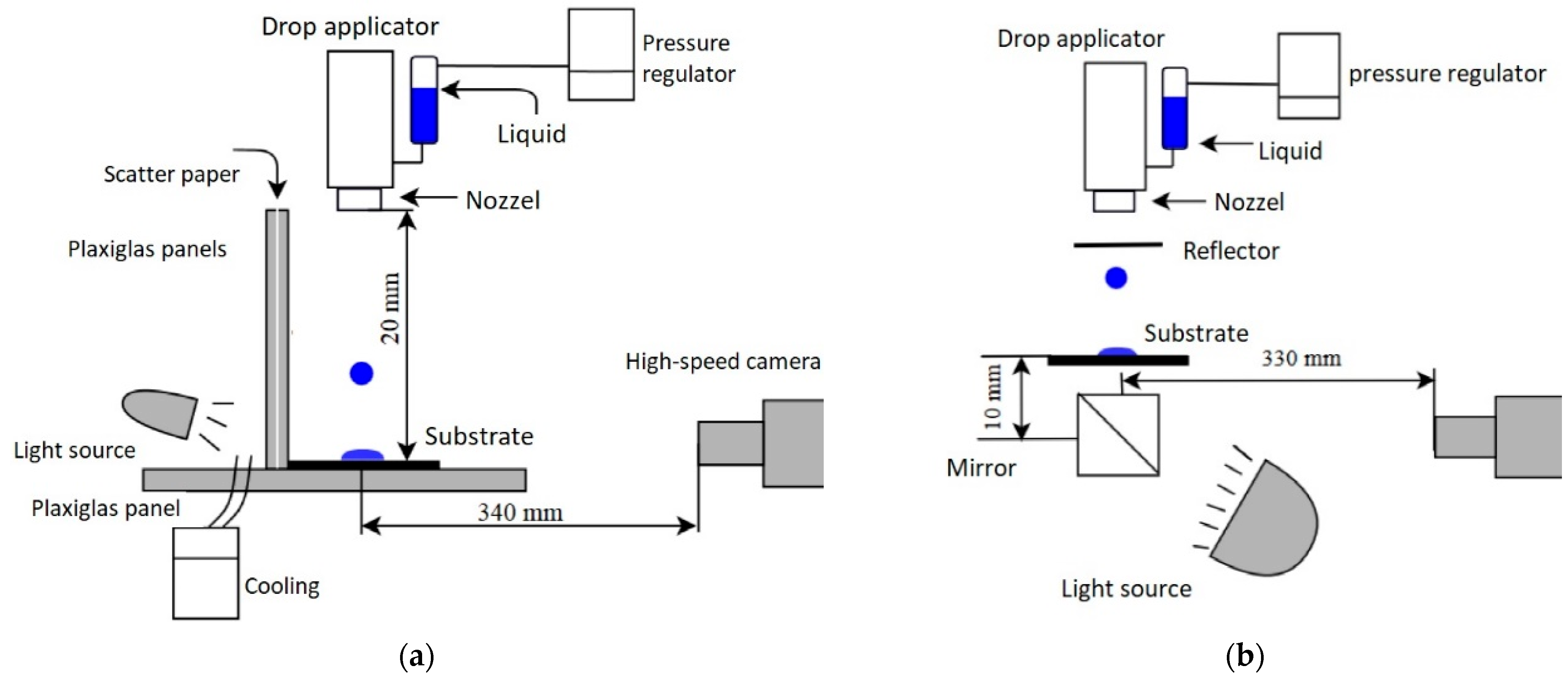

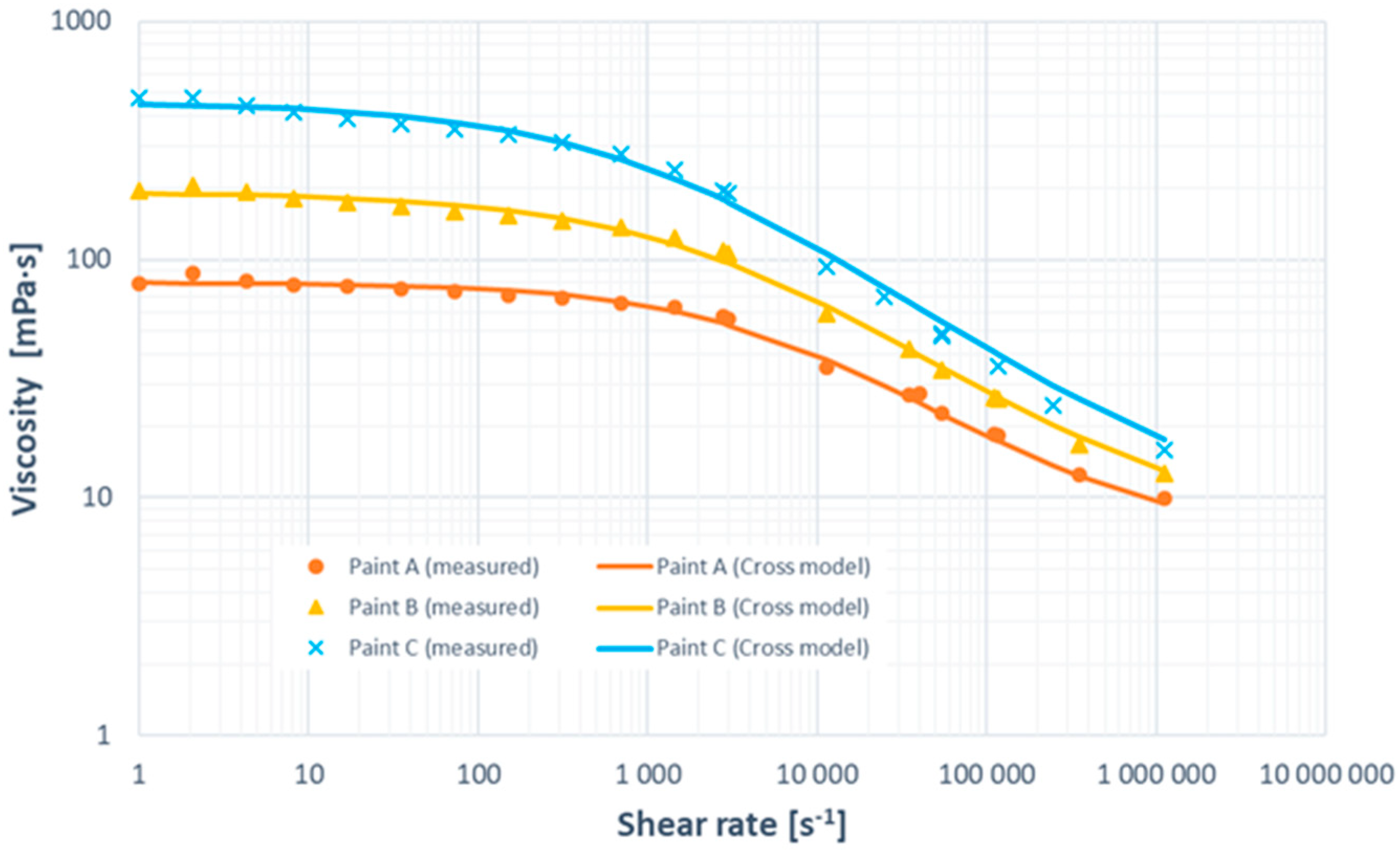


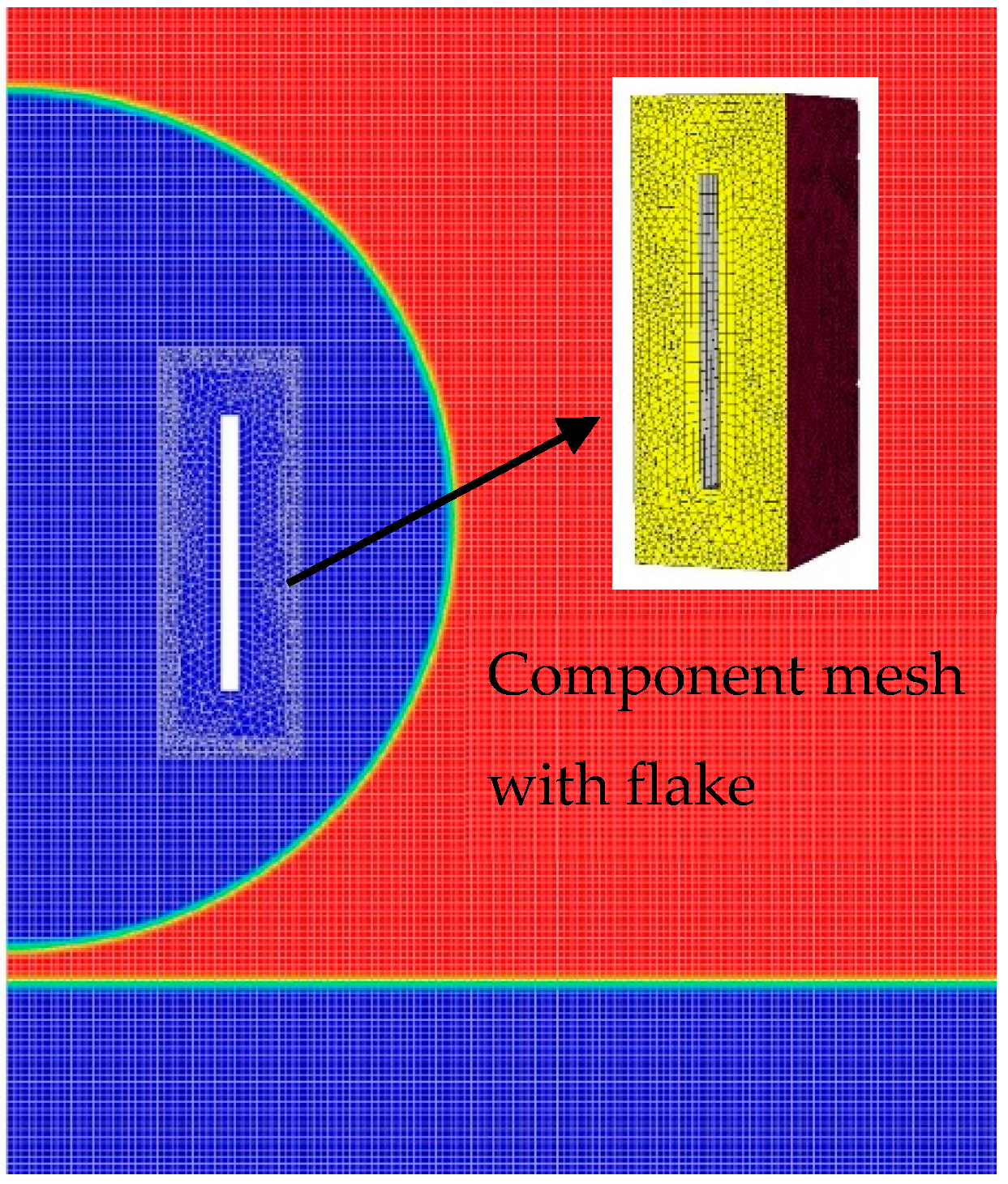

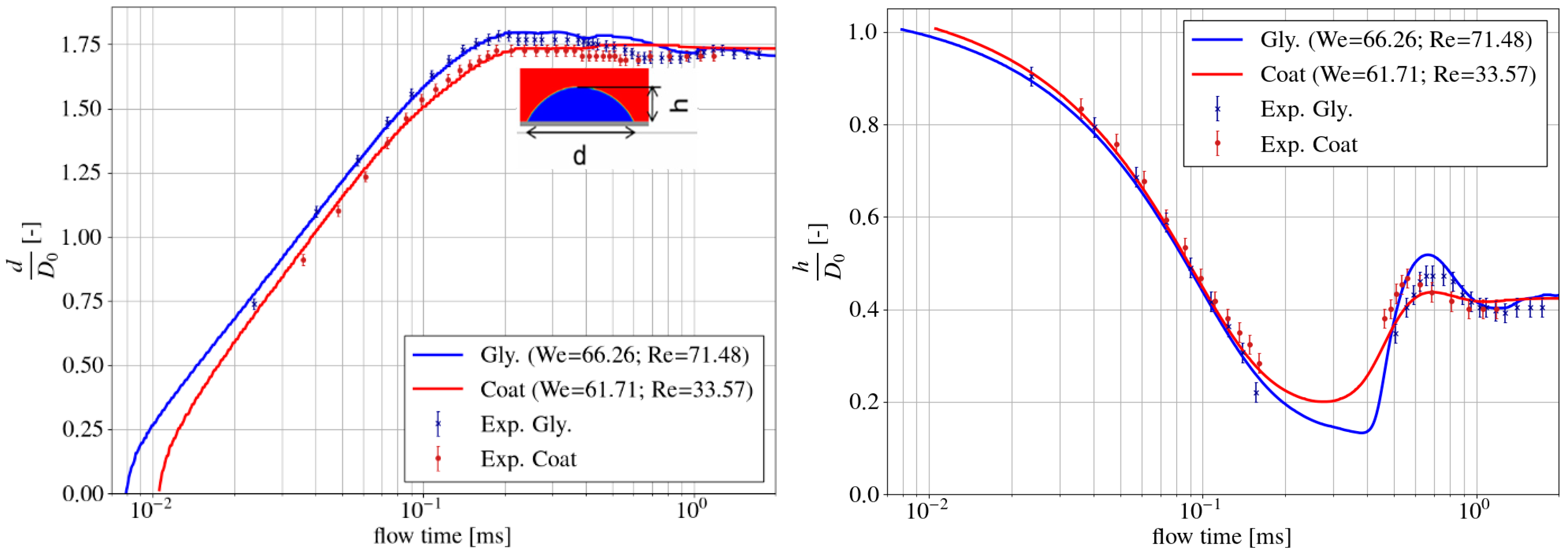



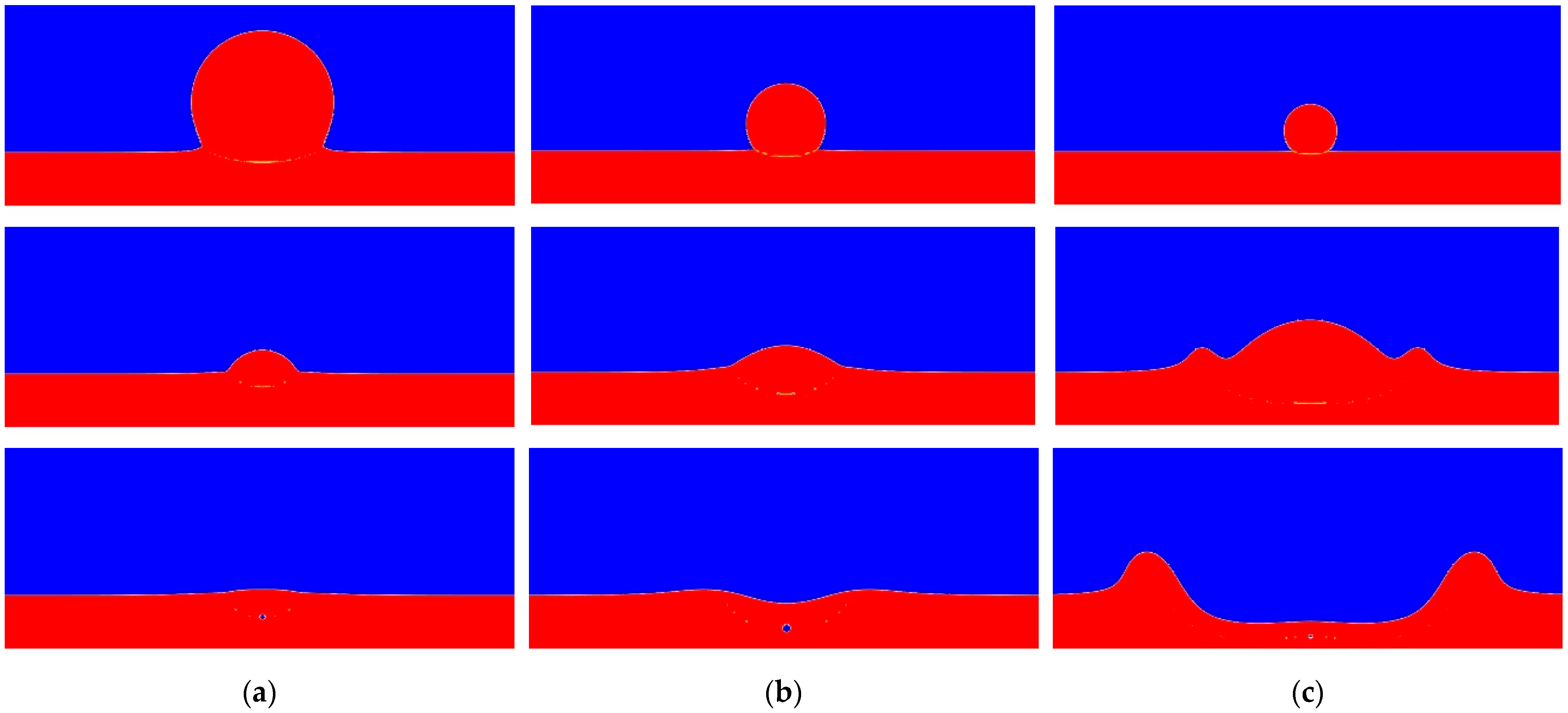
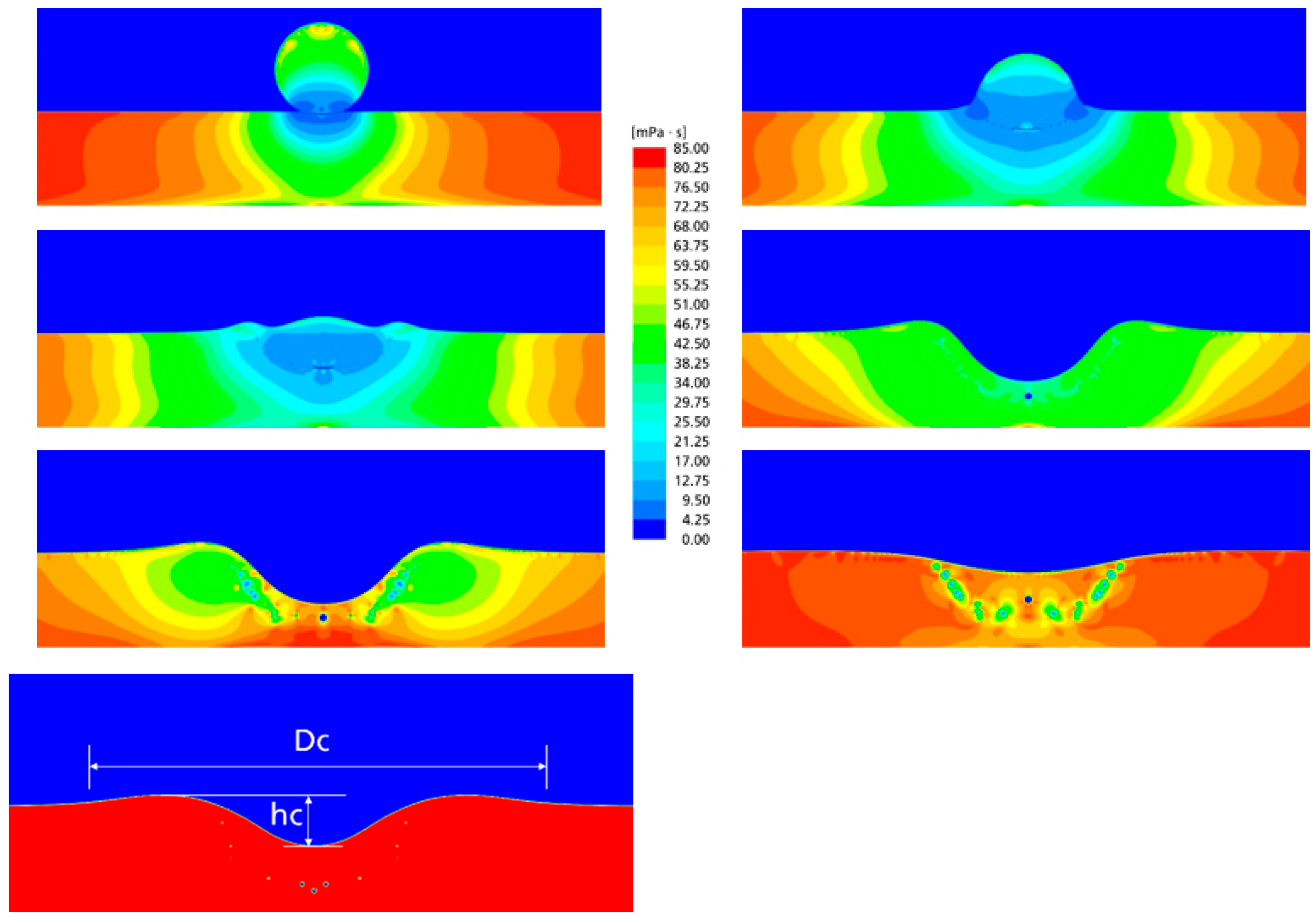
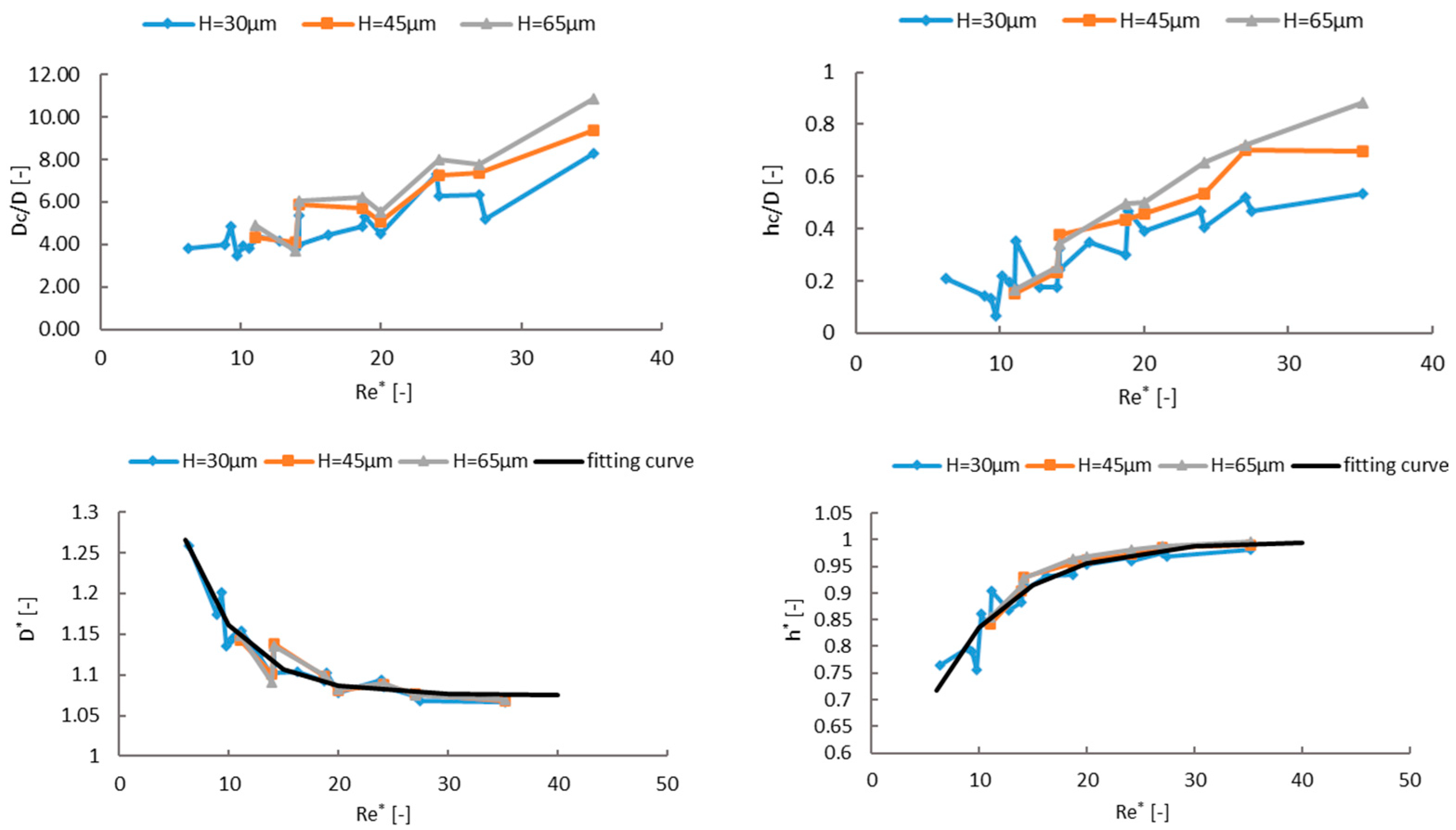


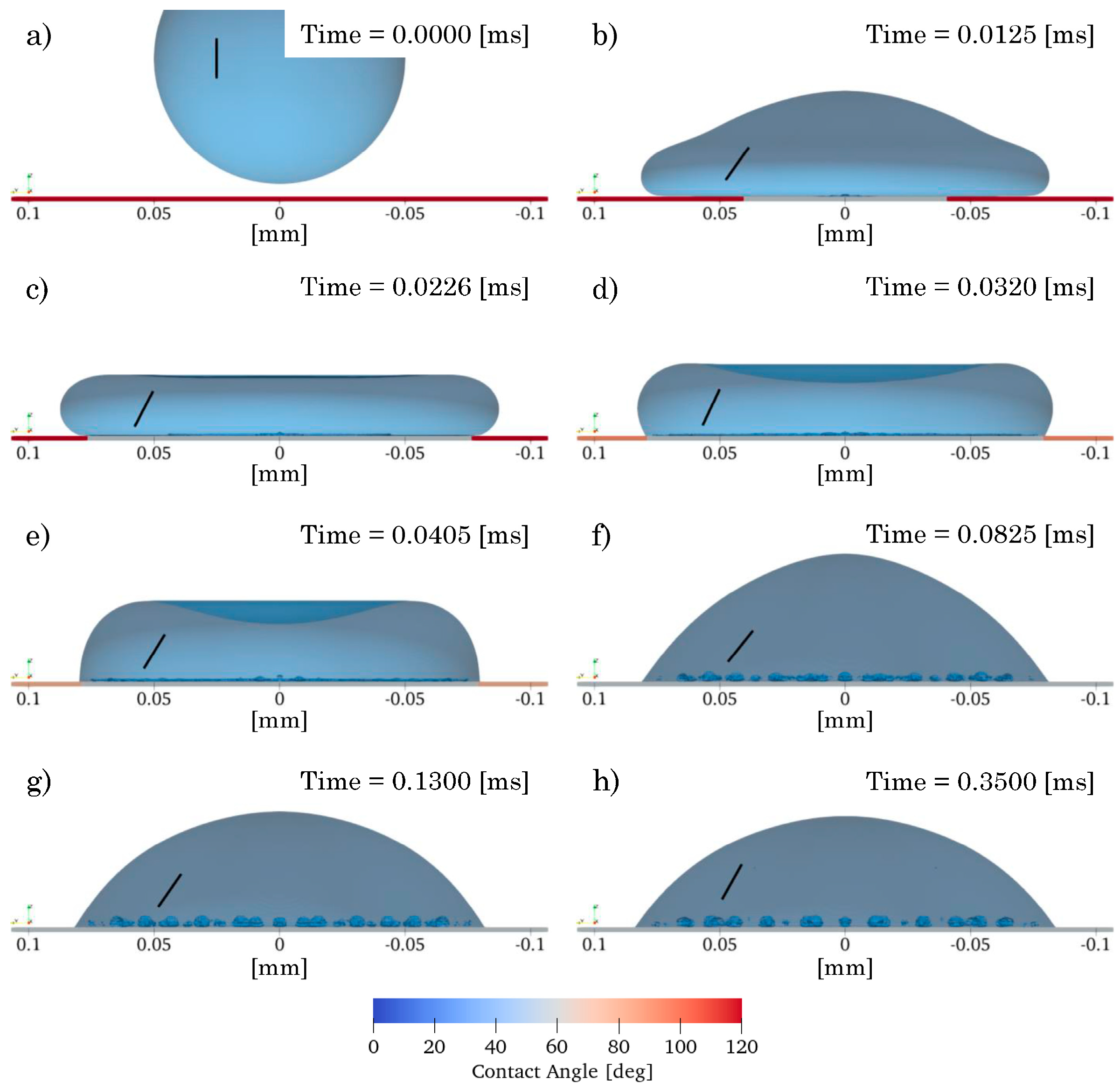
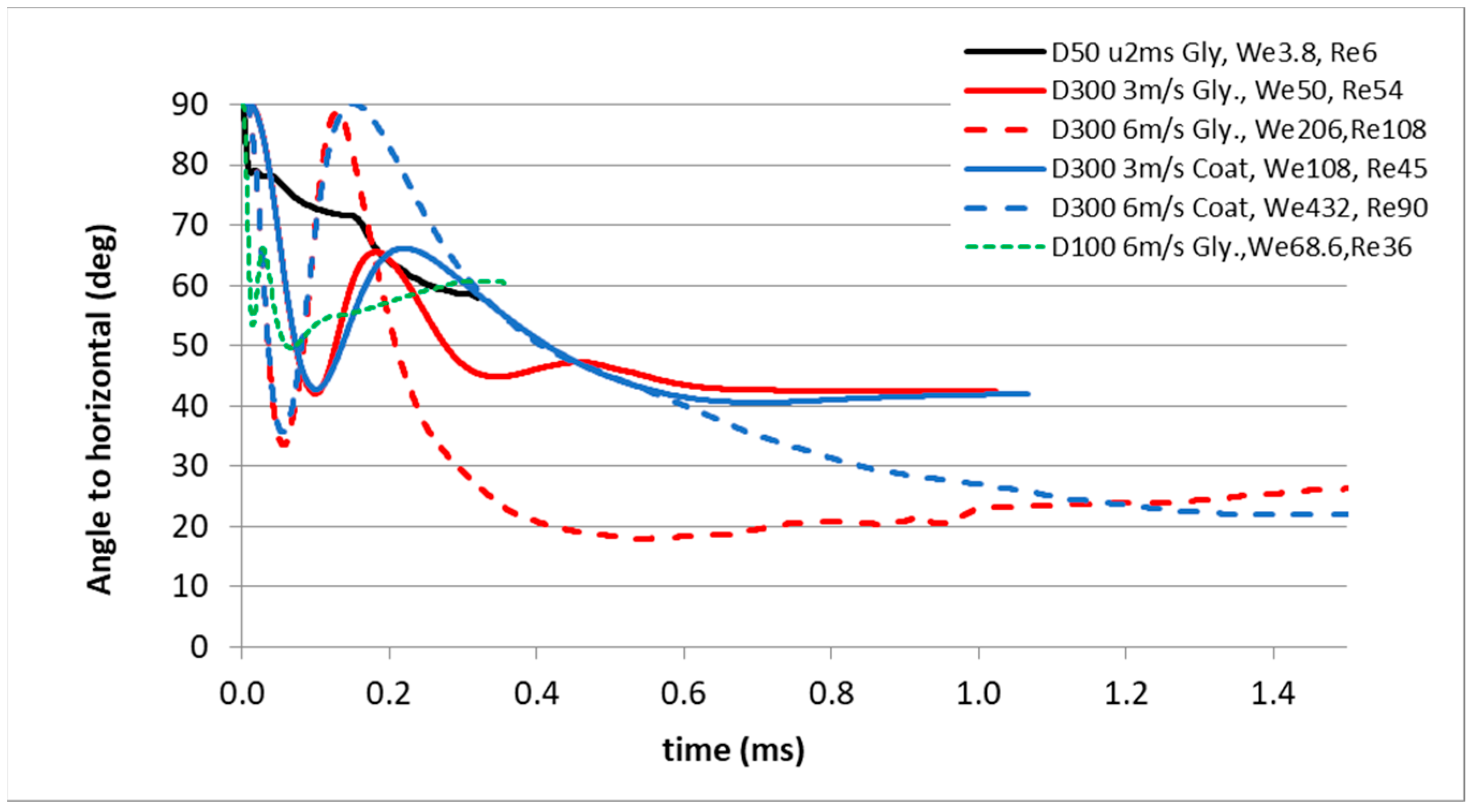

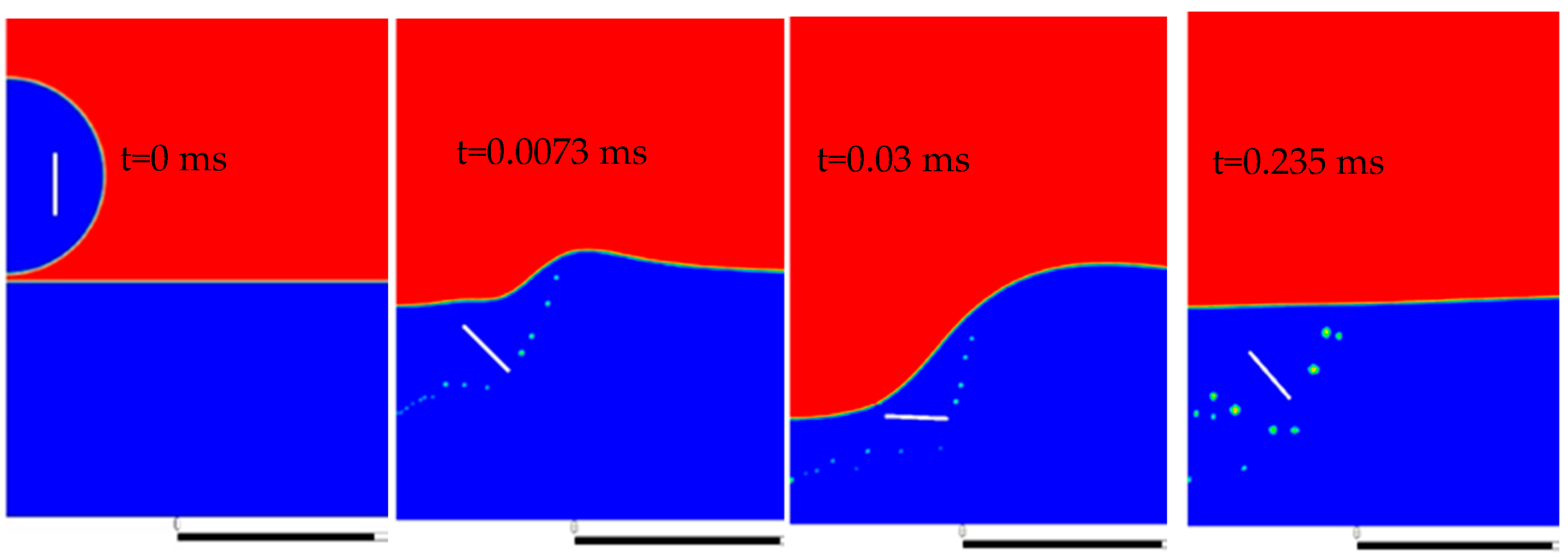

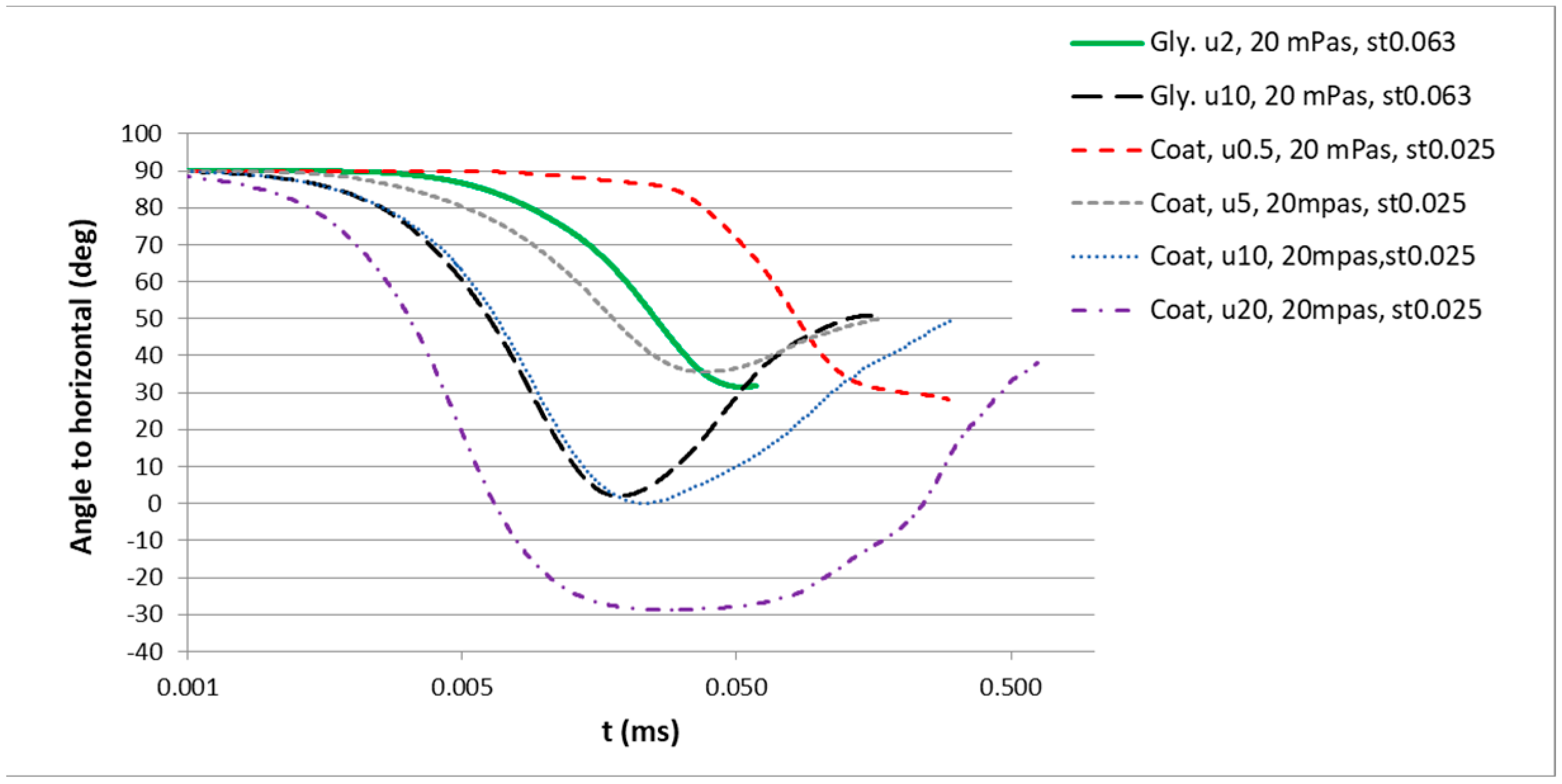
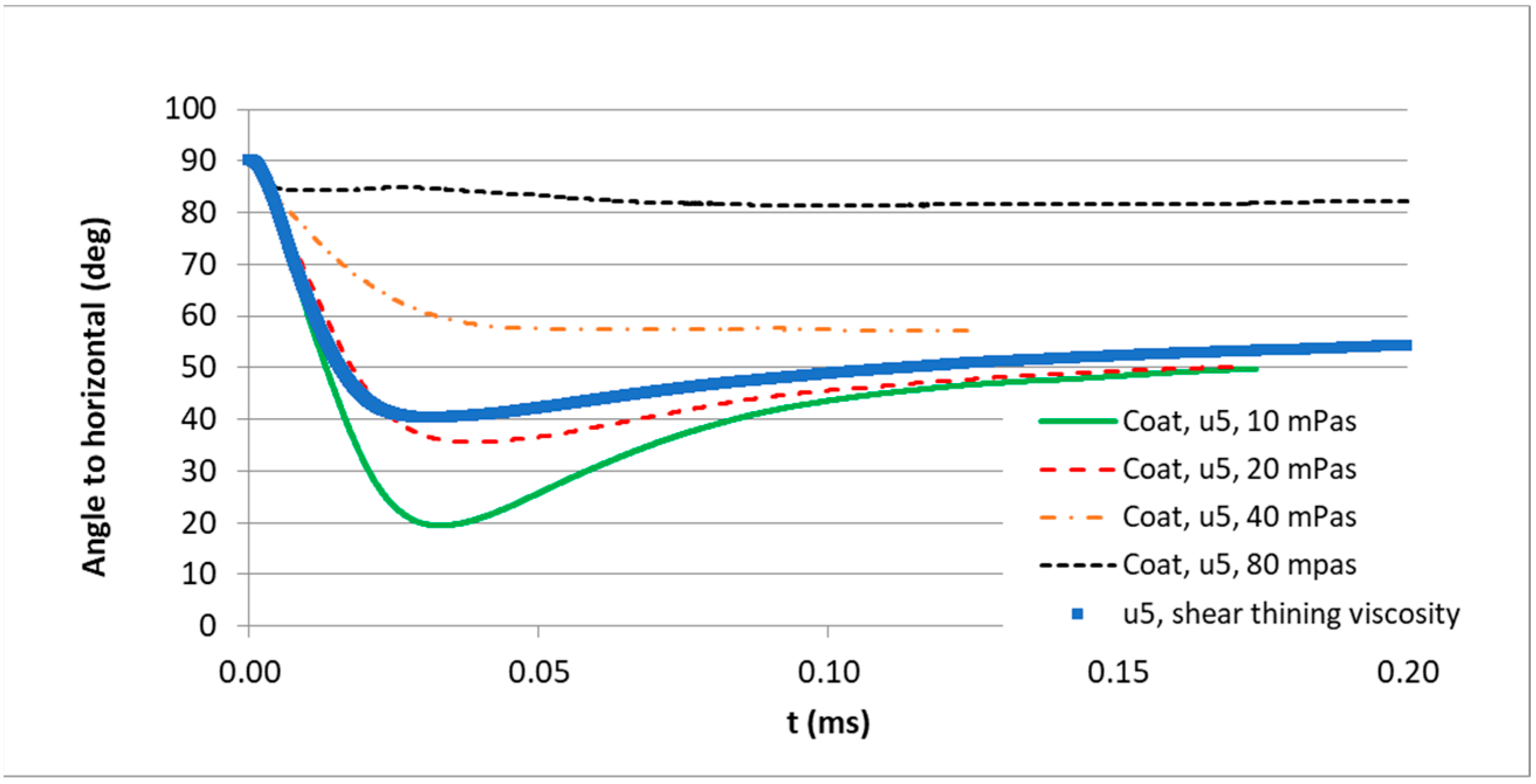

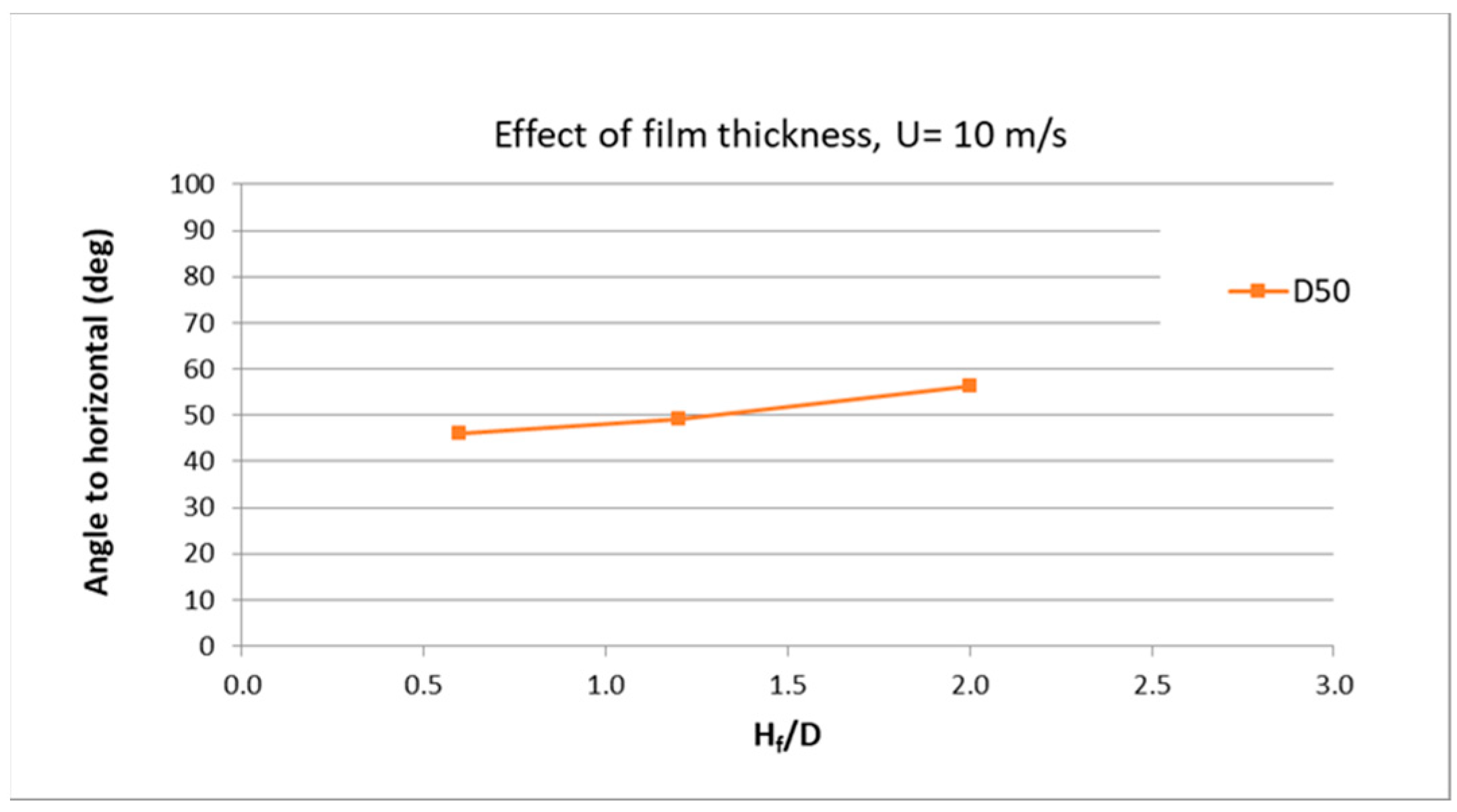

| Liquid | D (µm) | ρ (kg/m3) | σ (N/m) | η (Pa·s) | U (m/s) |
|---|---|---|---|---|---|
| Glycerol/water | 280–450 | 1200 | 0.063 | 0.02 | 1–3 |
| Waterborne paint | 280–450 | 1025 | 0.025 | Shear thinning | 1–3 |
| Droplet diameter D (µm) | 24, 50, 100, 300 | Flake size (µm3) | 1 × 16 × 16 |
| Droplet velocity U (m/s) | 0.5–20 | Flake density (kg/m3) | 3200 |
| Newtonian viscosity η (Pa·s) | 0.01–0.08 | Ratio of flake to droplet l/D | 0.053–0.32 |
| Non-Newtonian viscosity | Shear thinning | Re-number, Re = ρUD/η | 1–100 |
| Surface tension σ (N/m) | 0.025, 0.063 | We-number, We = ρU2D/σ | 3–1200 |
| Liquid density ρ (kg/m3) | 920, 1020, 1200 | Oh-number, Oh = η/√(σ D ρ) | 0.1–2.2 |
| Static contact angle (°) | 30, 50, 60 | ||
| Height of film (µm) | 30–65 |
Disclaimer/Publisher’s Note: The statements, opinions and data contained in all publications are solely those of the individual author(s) and contributor(s) and not of MDPI and/or the editor(s). MDPI and/or the editor(s) disclaim responsibility for any injury to people or property resulting from any ideas, methods, instructions or products referred to in the content. |
© 2025 by the authors. Licensee MDPI, Basel, Switzerland. This article is an open access article distributed under the terms and conditions of the Creative Commons Attribution (CC BY) license (https://creativecommons.org/licenses/by/4.0/).
Share and Cite
Ye, Q.; Tiedje, O.; Shen, B.; Domnick, J. Impact of Viscous Droplets on Dry and Wet Substrates for Spray Painting Processes. Fluids 2025, 10, 131. https://doi.org/10.3390/fluids10050131
Ye Q, Tiedje O, Shen B, Domnick J. Impact of Viscous Droplets on Dry and Wet Substrates for Spray Painting Processes. Fluids. 2025; 10(5):131. https://doi.org/10.3390/fluids10050131
Chicago/Turabian StyleYe, Qiaoyan, Oliver Tiedje, Bo Shen, and Joachim Domnick. 2025. "Impact of Viscous Droplets on Dry and Wet Substrates for Spray Painting Processes" Fluids 10, no. 5: 131. https://doi.org/10.3390/fluids10050131
APA StyleYe, Q., Tiedje, O., Shen, B., & Domnick, J. (2025). Impact of Viscous Droplets on Dry and Wet Substrates for Spray Painting Processes. Fluids, 10(5), 131. https://doi.org/10.3390/fluids10050131









